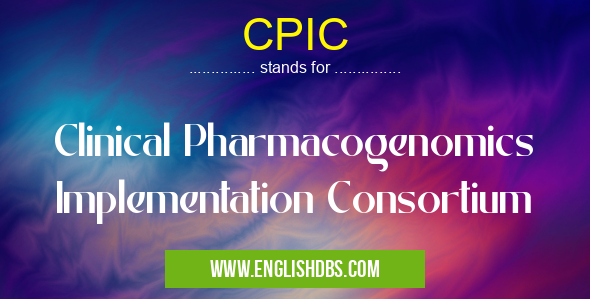What does CPIC mean in CLINICAL MEDICINE
The Clinical Pharmacogenomics Implementation Consortium, or CPIC, is a global organization that promotes the use of pharmacogenomics in clinical practice. Pharmacogenomics, also known as personalized medicine, uses genetic information to determine response to drugs and other treatments. By leveraging the latest advances in genetics and technology, CPIC works to ensure that all patients receive optimal drug therapy tailored to their individual needs.

CPIC meaning in Clinical Medicine in Medical
CPIC mostly used in an acronym Clinical Medicine in Category Medical that means Clinical Pharmacogenomics Implementation Consortium
Shorthand: CPIC,
Full Form: Clinical Pharmacogenomics Implementation Consortium
For more information of "Clinical Pharmacogenomics Implementation Consortium", see the section below.
Essential Questions and Answers on Clinical Pharmacogenomics Implementation Consortium in "MEDICAL»CLINICAL"
What is Clinical Pharmacogenomics Implementation Consortium (CPIC)?
CPIC is a worldwide research collaboration that works to provide evidence-based guidelines for individualizing patient treatment according to their genetic makeup. CPIC was founded in 2009 and is jointly sponsored by the American College of Medical Genetics and Genomics (ACMG) and the National Institutes of Health (NIH). The goal of CPIC is to ensure precision medicine by using genetics and genomics to create drug dosing guidelines that maximize therapeutic efficacy while minimizing side effects.
What kind of research does CPIC conduct?
CPIC conducts research on genes related to medication response, including how medications are absorbed, distributed, metabolized, or eliminated by the body. This research involves the identification of genetic variants that impact how patients respond to medications, allowing for personalized therapeutic decisions based on each person's unique genetic makeup.
How does CPIC improve treatments?
By understanding how different genetic variants can affect drug response, physicians can optimize medication selection and dosing to maximize therapeutic benefit while minimizing adverse effects. This approach allows for more precise recommendations for prescribing medicine based on an individual's genetics.
Who benefits from CPIC's work?
Everyone has unique genetic variations that can influence how they respond differently to medications - through improved treatments based on pharmacogenetic testing results, people can receive safer and more effective medications tailored specifically for them.
How do practitioners use CPIC's guidelines?
With the help of CPIC's Genetic Testing Guidelines, practitioners can utilize pharmacogenomic testing before prescribing medication or adjusting existing therapy in order to inform their decisions regarding the best choice of drug regimen. Additionally, these guidelines can help healthcare providers counsel their patients about possible risk factors associated with specific medications prior to starting therapy.
What types of drugs can be optimized with CPIC guidelines?
Currently, CPIC provides clinical actionable guidance on over 40 drugs across several disease states such as cancer, cardiovascular disease, diabetes and infectious diseases as well as enzyme-modulating drugs used for HIV treatment regimens. Through its continuous efforts in promoting precision medicine through pharmacogenetics/genomics testing among healthcare professionals, its scope will continue expanding into additional diseases and drug classes over time.
Does the use of pharmacogenetic testing have any risks? Do the benefits outweigh risks?
While there are some potential privacy issues associated with taking a pharmacogenetic test or having your genomic information stored in a laboratory database, there are numerous potential benefits when used correctly; both clinically and economically. The potential risks associated with such tests are outweighed by their usefulness in determining individualized therapies designed specifically for each patient's unique genome which helps optimize treatment decisions while minimizing risk.
Has there been any major achievement since its establishment in 2009?
Yes! In 2017 CPIC released its new guideline around gene-drug pairs involved antiretroviral agents utilized HIV patients designated HIV Group PPG3 — this guidance was co-sponsored International AIDS Society AIDS Clinical Society Europe initiated World Health Organization — this marked first time large scale organization joined hands create international consensus surrounding topic pharmacodynamics these groups global recognition.
Final Words:
CPIC strives to promote high quality patient care by harnessing the power of genetics in order to optimize drug therapy for each individual patient based on their unique genetic makeup. By providing evidence-based guidelines and educational resources along with innovative technological tools such as DDSS, CPIC helps ensure that physicians have reliable information when making highly informed decisions about treatments in order to provide their patients with the best possible outcomes.
